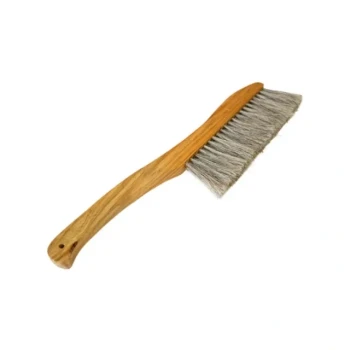At their core, the bristles of a bee brush are engineered for a specific paradox: they must be stiff enough to gently persuade bees to move off a frame, yet soft enough to do so without causing injury or alarm. This balance is the defining characteristic of the tool.
The purpose of a bee brush is not to apply force, but to provide a gentle and persuasive suggestion. Its bristles are designed to displace bees from a surface without harming them, which is critical for maintaining a calm and healthy hive.
The Core Principle: Balancing Stiffness and Softness
The effectiveness of a bee brush hinges entirely on the dual nature of its bristles. This design is a direct solution to the delicate task of moving thousands of fragile insects.
The Need for Stiffness
Bees, particularly when clustered on honeycomb, can be surprisingly stubborn. A brush with bristles that are too soft will simply glide over them without effect.
A degree of stiffness is necessary to physically dislodge the bees' grip on the comb, especially during honey harvesting when frames are full of bees.
The Mandate for Softness
While stiffness is needed to move bees, excessive rigidity is dangerous. A bee's legs, wings, and abdomen are fragile and easily damaged.
Crushing or injuring bees not only kills them but can trigger the release of alarm pheromones. This chemical signal instantly puts the rest of the colony on high alert, increasing defensive behavior and the risk of stings.
The Importance of Bristle Length
Most quality bee brushes feature long bristles. This is an intentional design choice.
Longer bristles allow for a wider, more fluid sweeping motion. This distributes the pressure over a larger area, making the interaction gentler and reducing the chance of pinning a bee against the comb.
Common Pitfalls and Best Practices
Simply owning a brush is not enough; using it correctly is key to avoiding stress within the hive. An improperly used brush can cause more problems than it solves.
The Risk of Agitation
Aggressive or rapid brushing is perceived as an attack by the bees. This will agitate the colony far more than a firm, quick shake of the frame.
The proper technique is a slow, upward "herding" motion, encouraging the bees to walk off the frame rather than forcibly sweeping them away.
The Danger of Harming the Queen
The single most important bee in the hive is the queen. A bee brush is an indiscriminate tool that cannot distinguish the queen from a worker bee.
Before you begin brushing any frame, always visually locate and confirm the safety of your queen. Accidentally injuring her can have catastrophic consequences for the colony.
Knowing the Alternatives
A brush is not always the best tool for the job. For clearing a large number of bees, a firm shake of the frame (over the hive) is often faster and less disruptive.
Many experienced beekeepers also use a single large feather, which provides an even gentler way to move just a few bees when needed.
Applying This to Your Beekeeping
Your goal dictates how and when you should use a bee brush.
- If your primary focus is clearing a frame for inspection: Use a gentle, upward sweeping motion to encourage bees to move, not to forcibly remove them.
- If your primary focus is harvesting honey: First, use a firm shake to dislodge the majority of bees, then use the brush to gently clear the few that remain.
- If your primary focus is protecting the queen: Always locate the queen before you begin brushing a frame to avoid accidentally injuring her.
Ultimately, the bee brush is a tool for finesse, designed to work with the bees' nature, not against it.
Summary Table:
| Characteristic | Purpose & Benefit |
|---|---|
| Balanced Stiffness & Softness | Stiff enough to dislodge bees; soft enough to prevent injury and alarm pheromone release. |
| Long Bristles | Distributes pressure for a gentler, sweeping motion, reducing the risk of pinning bees. |
| Gentle Persuasion | Designed to encourage bees to move, not to forcibly remove them, minimizing hive stress. |
Master the art of gentle hive management with the right tools from HONESTBEE.
For commercial apiaries and equipment distributors, using high-quality, purpose-built tools is essential for maintaining colony health and maximizing productivity. The right bee brush is a small but critical part of your operation.
HONESTBEE supplies durable, well-designed beekeeping supplies and equipment in bulk, ensuring your business has the reliable tools needed for efficient and humane beekeeping practices.
Contact HONESTBEE today to discuss your wholesale needs and equip your operation for success.
Visual Guide

Related Products
- Wooden Bee Brush with Triple Row Artificial Fiber for Beekeeping
- Wooden Bee Brush with Double-Row Horsehair Bristles
- Classic Wooden Bee Brush with Double-Row Boar Bristles
- Double Row Artificial Fiber Bee Brush for Beekeeping
- Premium Triple-Row Horsehair Bee Brush
People Also Ask
- Is a bee brush used to harm bees? Learn the Proper Tool for Gentle Beekeeping
- What is a bee brush and what is its primary use? A Gentle Tool for Hive Management
- What are some optional tools that can be useful in beekeeping? Boost Efficiency & Hive Health
- Why do beekeepers use a bee brush? The Essential Tool for Gentle Bee Handling
- What is a bee brush and how is it used in beekeeping? A Guide to Gentle Bee Handling



















